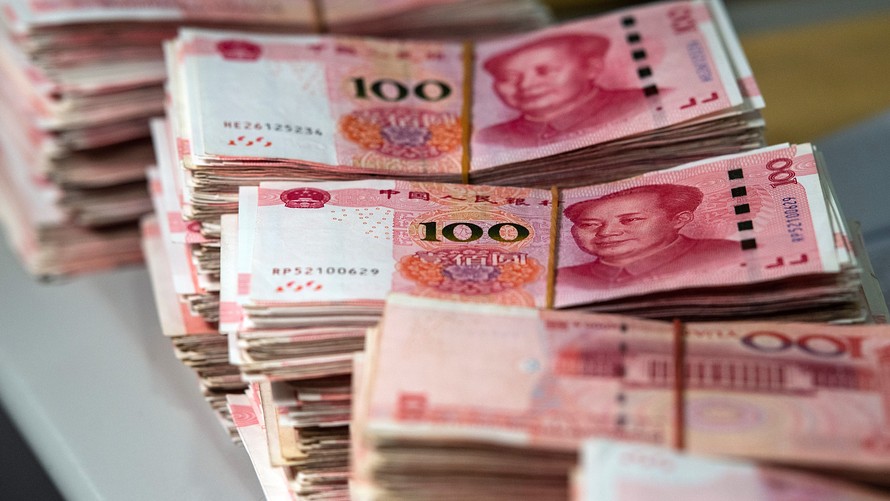
China’s yuan hit its lowest level since December 2016 during Friday’s Asia session, edging ever closer towards the psychologically important 7 yuan per dollar level that would represent a decade-long low.
Now, market participants are assessing whether Friday’s trading action, as well as the subsequent words from the People’s Bank of China, are a warning sign that more yuan weakness could come and the Chinese authorities are concerned about it.
PBOC Vice Gov. Pan Gongsheng said Friday that China’s healthy economic fundamentals as well as its foreign currency reserves will help keep its currency stable, according to a Reuters report. The central bank also has its eye on yuan short positions, Pan’s comments suggested, and will adopt macro-prudential measures to stabilize market expectations. Further, the Vice Gov. reiterated that devaluing the yuan as a tool in its trade spat with the U.S. was not an option.
This rhetoric seemed tougher than usual, Marc Ostwald, global strategist & chief economist at ADM Investor Services International, pointed out in a note on Friday, saying it “suggests concern as dollar-yuan approaches 7.00.”
The currency pair pulled back from its highs following the central banker’s comments. One dollar last bought 6.9435 yuan USDCNY, -0.0777% in Beijing, and 6.9564 yuan USDCNH, -0.0518% in the offshore market.
It “certainly seemed clear that the authorities were worried about what was happening,” wrote Simon Derrick, chief currency strategist at BNY Mellon, in emailed comments, adding that it was “interesting that [the comments] came as the six-month non-deliverable forward outright broke through 7 yuan [per dollar]. Is this the early warning indicator they were watching?”
A NDF is a type of short-term forward contract used for currency hedging, the profit or loss of which depends on the difference between the spot price and the agreed forward price at the settlement date. The fact that the six-month yuan NDF broke through the psychological 7.00 level shows that more weakness is expected.
Thus far, investors have attributed the yuan weakness to market forces, including a stronger U.S. dollar this year, as well as a selloff in emerging-market currencies over much of the summer.
“Whether [the PBOC] simply wanted to dramatically slow the move or were drawing their own ‘line in the sand’ is open to debate,” Derrick added. One way or another, investors will be watching closely to see whether Chinese officials will step in to discourage a rapid move lower in the yuan.
Besides the dip in its currency, China’s stocks including the benchmark Shanghai Composite Index SHCOMP, -0.19% also ended the week lower. Last week Friday’s third quarter GDP report spooked global financial markets, showing China’s economy had expanded at its slowest pace since the financial crisis and less than economists had expected.
Friday’s weakness was visible elsewhere again, with haven assets like the Japanese yen USDJPY, -0.48% and gold GCZ8, +0.24% gaining traction, while risk-sensitive assets gave in.
The Australian dollar AUDUSD, +0.1413% , for example — which is both a risk-sensitive currency but also a preferred developed market proxy for China due to the close trade ties between Beijing and Canberra — dropped a 33-month low.
A slowing in China’s economy, and more specifically its infrastructure and real estate complex, could hurt Australia badly as it exports a lot of iron ore to China. While China is still a big exporting economy, it has also become the world’s third largest importer, and is the largest importer of copper and iron ore in the world, wrote Bank of America Merrill Lynch global economists Ethan Harris and Aditya Bhave.
Helen Qiao, chief greater China economist at BAML, expects “the Chinese government to steadily ramp up stimulus measures to prevent a hard landing, but they still see growth weakening further in the next three to six months.” In 2019, GDP should slow to 6.1%, Qiao predicts, though data smoothing may not show the full extent of the weakness, which will nonetheless weigh on global markets.
South Korean stocks SEU, -1.75% are among those bearing the highest risk in terms of feeling the pain from a China downturn because, much like other Asian economies, South Korea is exposed to the Chinese supply chain. Meanwhile “regions such as Europe are more exposed to Chinese final demand,” Harris and Bhave wrote, and U.S. stocks DJIA, -1.19% SPX, -1.73% prove sensitive to negative China news, more so than positive news.
For now, investors will have to wait and see how the trade spat between Washington and Beijing plays out and what effect China’s new economic stimulus initiatives will have.





























